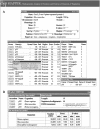The MAPPER database: a multi-genome catalog of putative transcription factor binding sites
- PMID: 15608292
- PMCID: PMC540057
- DOI: 10.1093/nar/gki103
The MAPPER database: a multi-genome catalog of putative transcription factor binding sites
Abstract
We describe a comprehensive map of putative transcription factor binding sites (TFBSs) across multiple genomes created using a search method that relies on hidden Markov models built from experimentally determined TFBSs. Using the information in the TRANSFAC and JASPAR databases, we built 1134 models for TFBSs and used them to scan regions 10 kb upstream of the start of the transcript for all known genes in the human, mouse and Drosophila melanogaster genomes. The results, together with homology information on clusters of ortholog genes across the three genomes, were used to create a multi-organism catalog of annotated TFBSs. The catalog can be queried through a web interface accessible at http://bio.chip.org/mapper that allows the identification, visualization and selection of TFBSs occurring in the promoter of a gene of interest and also the common factors predicted to bind across the cluster of orthologs that includes that gene. Alternatively, the interface allows the user to retrieve binding sites for a single transcription factor of interest in a single gene or in all genes of the human, mouse or fruit fly genomes.
Figures


Similar articles
-
MAPPER: a search engine for the computational identification of putative transcription factor binding sites in multiple genomes.BMC Bioinformatics. 2005 Mar 30;6:79. doi: 10.1186/1471-2105-6-79. BMC Bioinformatics. 2005. PMID: 15799782 Free PMC article.
-
ABS: a database of Annotated regulatory Binding Sites from orthologous promoters.Nucleic Acids Res. 2006 Jan 1;34(Database issue):D63-7. doi: 10.1093/nar/gkj116. Nucleic Acids Res. 2006. PMID: 16381947 Free PMC article.
-
JASPAR: an open-access database for eukaryotic transcription factor binding profiles.Nucleic Acids Res. 2004 Jan 1;32(Database issue):D91-4. doi: 10.1093/nar/gkh012. Nucleic Acids Res. 2004. PMID: 14681366 Free PMC article.
-
SwissRegulon: a database of genome-wide annotations of regulatory sites.Nucleic Acids Res. 2007 Jan;35(Database issue):D127-31. doi: 10.1093/nar/gkl857. Epub 2006 Nov 27. Nucleic Acids Res. 2007. PMID: 17130146 Free PMC article.
-
[The databases of transcription factors.].Yi Chuan. 2010 Oct;32(10):1009-17. doi: 10.3724/sp.j.1005.2010.01009. Yi Chuan. 2010. PMID: 20943488 Review. Chinese.
Cited by
-
The MAPPER2 Database: a multi-genome catalog of putative transcription factor binding sites.Nucleic Acids Res. 2012 Jan;40(Database issue):D155-61. doi: 10.1093/nar/gkr1080. Epub 2011 Nov 24. Nucleic Acids Res. 2012. PMID: 22121218 Free PMC article.
-
Polymorphisms in uracil-processing genes, but not one-carbon nutrients, are associated with altered DNA uracil concentrations in an urban Puerto Rican population.Am J Clin Nutr. 2009 Jun;89(6):1927-36. doi: 10.3945/ajcn.2009.27429. Epub 2009 Apr 29. Am J Clin Nutr. 2009. PMID: 19403629 Free PMC article.
-
Visualization and exploration of conserved regulatory modules using ReXSpecies 2.BMC Evol Biol. 2011 Sep 24;11:267. doi: 10.1186/1471-2148-11-267. BMC Evol Biol. 2011. PMID: 21942985 Free PMC article.
-
Snail regulates BMP and TGFβ pathways to control the differentiation status of glioma-initiating cells.Oncogene. 2018 May;37(19):2515-2531. doi: 10.1038/s41388-018-0136-0. Epub 2018 Feb 16. Oncogene. 2018. PMID: 29449696 Free PMC article.
-
In silico analysis identifies a novel role for androgens in the regulation of human endometrial apoptosis.J Clin Endocrinol Metab. 2011 Nov;96(11):E1746-55. doi: 10.1210/jc.2011-0272. Epub 2011 Aug 24. J Clin Endocrinol Metab. 2011. PMID: 21865353 Free PMC article.
References
-
- Davidson E.H., Rast,J.P., Oliveri,P., Ransick,A., Calestani,C., Yuh,C.H., Minokawa,T., Amore,G., Hinman,V., Arenas-Mena,C. et al. (2002) A genomic regulatory network for development. Science, 295, 1669–1678. - PubMed
-
- Levine M. and Tjian,R. (2003) Transcription regulation and animal diversity. Nature, 424, 147–151. - PubMed
-
- Bailey T.L. and Noble,W.S. (2003) Searching for statistically significant regulatory modules. Bioinformatics, 19 (Suppl. 2), II16–II25. - PubMed
-
- Sinha S., Van Nimwegen,E. and Siggia,E.D. (2003) A probabilistic method to detect regulatory modules. Bioinformatics, 19 (Suppl. 1), I292–I301. - PubMed
MeSH terms
Substances
LinkOut - more resources
Full Text Sources
Other Literature Sources

